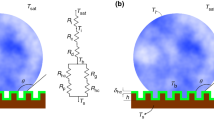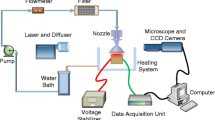Abstract
Dropwise condensation (DWC) is one of the phase change heat transfer regimes, which due to its high capacity has received much attention from investigators. To produce DWC, it is necessary to have hydrophobic surfaces. Low surface energy coatings have been usually used to produce hydrophobic surfaces. These coatings due to their low thermal conductivities must have the minimum thickness. Therefore, self-assembled monolayers coatings like stearic acid or 1-octadecanethiol coatings (with thicknesses as high as a few nanometers) have been used in the literature. To create hydrophobic coatings by these materials, the surfaces are immersed in hydrophobic solutions with particular concentrations and in a specific time. There is not any general investigation on the effects of the time and concentration of these coatings on DWC in the literature. In this study, first, a proper apparatus for DWC experiments is designed and fabricated. Then, the effects of concentration and immersing time of the two mentioned materials on DWC phenomena have been studied. Between four coating times and solution concentrations of 1-octadecanethiol, concentration of 0.025 M at coating time of 30 min increases DWC heat transfer coefficient by about 4–7 times with respect to filmwise condensation in different subcooling temperatures. Concentration of 0.0025 M at coating time of 1 hour of stearic acid also increases the heat transfer coefficient by about 3–4 times. As well as the 1-octadecanethiol coating has a more uniform structure and higher heat transfer coefficient with respect to stearic acid coating.














Similar content being viewed by others
Abbreviations
- d :
-
Diameter of a hole (m)
- g :
-
Gravitational acceleration (m/s2)
- h :
-
Heat transfer coefficient (W/(m2 K))
- H :
-
Latent heat (J/kg)
- k :
-
Thermal conductivity (W/(m K))
- N :
-
Number of temperature measurement locations
- M :
-
Molar or mole per liter
- q :
-
Heat flux (W/m2)
- R :
-
Sample forehead surface radius (m)
- S :
-
Uncertainty
- T :
-
Temperature (K)
- x :
-
Location (m)
- µ :
-
Dynamic viscosity (Pa s)
- ρ :
-
Density (kg/m3)
- FWC:
-
Filmwise condensation
- g :
-
Gradient
- i :
-
ith thermocouple
- l :
-
Liquid (condensate)
- lg:
-
Liquid gas
- q :
-
Related to heat flux
- v :
-
Vapor
- w :
-
Wall
References
Zarei S, Talesh Bahrami HR, Saffari H (2018) Effects of geometry and dimension of micro/nano-structures on the heat transfer in dropwise condensation: a theoretical study. Appl Therm Eng 137:440–450
Miljkovic N, Enright R, Wang EN (2013) Modeling and optimization of superhydrophobic condensation. J Heat Transf 135(11):111004
Rose Jw (1967) On the mechanism of dropwise condensation. Int J Heat Mass Transf 10(6):755–756
Quan X, Chen S, Li J, Cheng P (2018) Enhanced dropwise condensation by oil infused nano-grass coatings on outer surface of a horizontal copper tube. Int Commun Heat Mass Transf 91:11–16
Martin H, Barati SB, Pinoli J-C, Valette S, Gavet Y (2018) Segmentation of gray scale images of dropwise condensation on textured surfaces. World Acad Sci Eng Technol Int J Comput Inf Eng 5(1):115–126
Zhao Y, Preston DJ, Lu Z, Zhang L, Queeney J, Wang EN (2018) Effects of millimetric geometric features on dropwise condensation under different vapor conditions. Int J Heat Mass Transf 119:931–938
Talesh Bahrami HR, Saffari H (2017) Theoretical study of stable dropwise condensation on an inclined micro/nano-structured tube. Int J Refrig 75(Supplement C):141–154
Talesh Bahrami HR, Saffari H (2017) Mathematical modeling and numerical simulation of dropwise condensation on an inclined circular tube. J Aerosp Technol Manag 9(4):476–488
Kim S, Kim KJ (2011) Dropwise condensation modeling suitable for superhydrophobic surfaces. J Heat Transf 133(8):081502/1–081502/8
Patankar NA (2010) Supernucleating surfaces for nucleate boiling and dropwise condensation heat transfer. Soft Matter 6(8):1613–1620
O’neill GA, Westwater JW (1984) Dropwise condensation of steam on electroplated silver surfaces. Int J Heat Mass Transf 27(9):1539–1549
Cai Z, Lin J, Hong X (2018) Transparent superhydrophobic hollow films (TSHFs) with superior thermal stability and moisture resistance. RSC Adv 8(1):491–498
Bita I, Yang JKW, Jung YS, Ross CA, Thomas EL, Berggren KK (2008) Graphoepitaxy of self-assembled block copolymers on two-dimensional periodic patterned templates. Science 321(5891):939–943
Fleet LR, Stott J, Villis B, Din S, Serri M, Aeppli G, Heutz S, Nathan A (2017) Self-assembled molecular nanowires for high-performance organic transistors. ACS Appl Mater Interfaces 9(24):20686–20695
Bandyopadhyay K, Vijayamohanan K, Venkataramanan M, Pradeep T (1999) Self-assembled monolayers of small aromatic disulfide and diselenide molecules on polycrystalline gold films: a comparative study of the geometrical constraint using temperature-dependent surface-enhanced Raman spectroscopy, X-ray photoelectron spectroscopy, and electrochemistry. Langmuir 15(16):5314–5322
Das AK, Kilty HP, Marto PJ, Andeen GB, Kumar A (1999) The use of an organic self-assembled monolayer coating to promote dropwise condensation of steam on horizontal tubes. J Heat Transf 122(2):278–286
Chen C-H, Cai Q, Tsai C, Chen C-L, Xiong G, Yu Y, Ren Z (2007) Dropwise condensation on superhydrophobic surfaces with two-tier roughness. Appl Phys Lett 90(17):173108
Vemuri S, Kim KJ, Wood BD, Govindaraju S, Bell TW (2006) Long term testing for dropwise condensation using self-assembled monolayer coatings of n-octadecyl mercaptan. Appl Therm Eng 26(4):421–429
Yang Q, Gu A (2006) Dropwise condensation on SAM and electroless composite coating surfaces. J Chem Eng Jpn 39(8):826–830
Torresin D, Tiwari MK, Del Col D, Poulikakos D (2013) Flow condensation on copper-based nanotextured superhydrophobic surfaces. Langmuir 29(2):840–848
Chen L, Liang S, Yan R, Cheng Y, Huai X, Chen S (2009) N-octadecanethiol self-assembled monolayer coating with microscopic roughness for dropwise condensation of steam. J Therm Sci 18(2):160–165
Vemuri S, Kim KJ, Kang YT (2006) A study on effective use of heat transfer additives in the process of steam condensation. Int J Refrig 29(5):724–734
Kedzierski MA, Worthington III JL (1993) Design and machining of copper specimens with micro holes for accurate heat transfer measurements. Exp Heat Transf 6(4):329–344
ImageJ. Available: https://imagej.nih.gov/ij/. Accessed 07 Dec 2017
Vemuri S, Kim KJ (2006) An experimental and theoretical study on the concept of dropwise condensation. Int J Heat Mass Transf 49(3):649–657
Abu-Orabi M (1998) Modeling of heat transfer in dropwise condensation. Int J Heat Mass Transf 41(1):81–87
Peng B, Ma X, Lan Z, Xu W, Wen R (2015) Experimental investigation on steam condensation heat transfer enhancement with vertically patterned hydrophobic-hydrophilic hybrid surfaces. Int J Heat Mass Transf 83:27–38
Zhong L, Xuehu M, Sifang W, Mingzhe W, Xiaonan L (2010) Effects of surface free energy and nanostructures on dropwise condensation. Chem Eng J 156(3):546–552
Bonner III RW (2010) Dropwise condensation life testing of self-assembled monolayers. In: Proceedings of the 14th international heat transfer conference. Washington, DC, pp 221–226
Wang Q, Zhang B, Qu M, Zhang J, He D (2008) Fabrication of superhydrophobic surfaces on engineering material surfaces with stearic acid. Appl Surf Sci 254(7):2009–2012
Ahmadi B, Talesh Bahrami HR, Saffari H (2016) Production of superhydrophobic copper surfaces by fabricating micro-nano features using wet etching process. Modares Mech Eng 16(5):389–395
Miljkovic N (2013) Development and characterization of micro/nano structured surfaces for enhanced condensation. Ph.D. thesis, Massachusetts Institute of Technology
Karaipekli A, Sarı A, Kaygusuz K (2007) Thermal conductivity improvement of stearic acid using expanded graphite and carbon fiber for energy storage applications. Renew. Energy 32(13):2201–2210
Author information
Authors and Affiliations
Corresponding author
Additional information
Technical Editor: Cezar Negrao, PhD.
Publisher's Note
Springer Nature remains neutral with regard to jurisdictional claims in published maps and institutional affiliations.
Rights and permissions
About this article
Cite this article
Talesh Bahrami, H.R., Azizi, A. & Saffari, H. Influence of different parameters of preparing self-assembled monolayers on copper surfaces in the dropwise condensation heat transfer: an experimental study. J Braz. Soc. Mech. Sci. Eng. 41, 159 (2019). https://doi.org/10.1007/s40430-019-1660-8
Received:
Accepted:
Published:
DOI: https://doi.org/10.1007/s40430-019-1660-8




